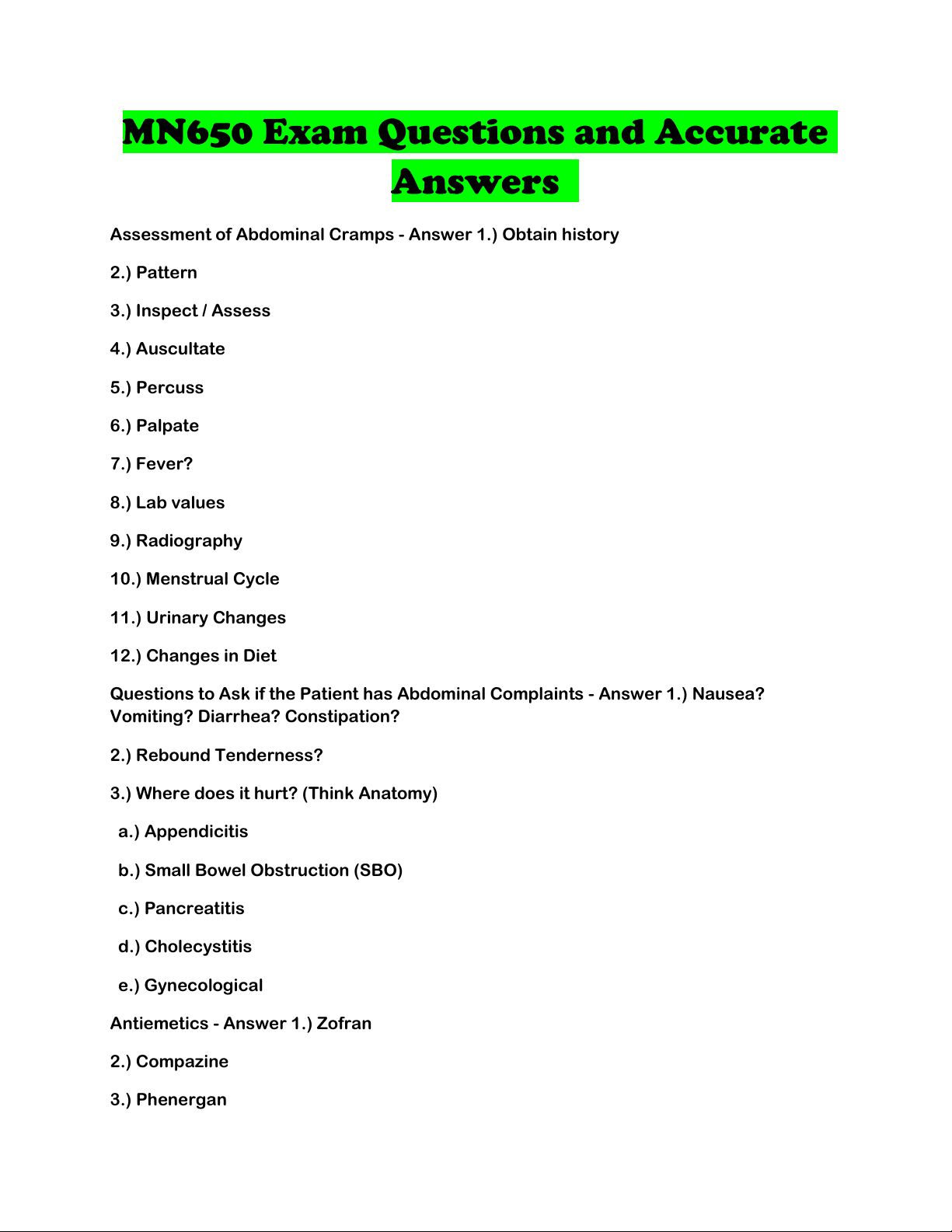






Study with the several resources on Docsity

Earn points by helping other students or get them with a premium plan


Prepare for your exams
Study with the several resources on Docsity

Earn points to download
Earn points by helping other students or get them with a premium plan
Community
Ask the community for help and clear up your study doubts
Discover the best universities in your country according to Docsity users
Free resources
Download our free guides on studying techniques, anxiety management strategies, and thesis advice from Docsity tutors
A concise overview of key concepts related to the assessment and management of abdominal pain, including differential diagnoses based on pain location, relevant lab values, and treatment options for various gastrointestinal conditions. It covers topics such as appendicitis, bowel obstruction, pancreatitis, cholecystitis, and ulcers, offering practical insights for medical students and healthcare professionals. The document also addresses important considerations like referred pain, peritonitis, and gi bleeds, making it a valuable resource for quick reference and exam preparation. This material is useful for medical students and healthcare professionals.
Typology: Exams
1 / 8

This page cannot be seen from the preview
Don't miss anything!





Assessment of Abdominal Cramps - Answer 1.) Obtain history 2.) Pattern 3.) Inspect / Assess 4.) Auscultate 5.) Percuss 6.) Palpate 7.) Fever? 8.) Lab values 9.) Radiography 10.) Menstrual Cycle 11.) Urinary Changes 12.) Changes in Diet Questions to Ask if the Patient has Abdominal Complaints - Answer 1.) Nausea? Vomiting? Diarrhea? Constipation? 2.) Rebound Tenderness? 3.) Where does it hurt? (Think Anatomy) a.) Appendicitis b.) Small Bowel Obstruction (SBO) c.) Pancreatitis d.) Cholecystitis e.) Gynecological Antiemetics - Answer 1.) Zofran 2.) Compazine 3.) Phenergan
4.) Reglan What kind of pain do the stomach, duodenum, liver, and pancreas cause? (Foregut) - Answer upper abdominal pain. What kind of pain do small bowel, proximal colon, and appendix cause? (Midgut) - Answer periumbilical pain What kind of pain do distal colon and genitourinary tract cause? (Hindgut) - Answer lower abdominal pain Somatic Pain - Answer comes from the parietal peritoneum. pain is sharp and well localized. Referred pain - Answer pain perceived distant from its source and results from convergence of nerve fibers at the spinal cord. Examples of Referred Pain - Answer 1.) scapular pain due to biliary colic, 2.) groin pain due to renal colic 3.) shoulder pain due to blood or infection irritating the diaphragm. Peritonitis - Answer inflammation of the peritoneal cavity; may be due to chemical irritation or bacterial invasion What do you not give if a patient is suspected gastrointestinal tract perforation. - Answer Barium because it causes severe caking and peritonitis spontaneous bacterial peritonitis - Answer the peritoneal cavity is infected by blood-borne bacteria. Occurs with Cirrhosis and ascites pts Pain in the right upper quadrant is from what body parts? - Answer 1.) Appendicitis with a gravid uterus 2.) Cholecystitis with biliary colic 3.) Congestive Heptomegally 4.) Hepatitis or Hepatic abscess 5.) Perforated duodenal ulcer Pain in the epigastric (right or left upper quadrants) is from what body parts? - Answer 1.) Acute pancreatitis 2.) Herpes Zoster 3.) Lower lobe pneumonia 4.) MI
4.) Abdominal distention
bowel obstruction. - Answer Distention, especially when surgical scars, tympany to percussion, and high-pitched peristalsis or borborygmi in rushes are present
Peritonitis - Answer Severe pain in a patient with a silent abdomen who is lying as still a
Back pain with shock suggests what, especially if tender and pulsatile mass? - Answer abdominal aortic aneurysm,
Ecchymoses of the costovertebral angles (Grey Turner sign) or around the umbilicus (Cullen sign) suggest - Answer hemorrhagic pancreatitis
A patient who is writhing around trying to get comfortable is more likely to have an - Answer obstructive mechanism (eg, renal or biliary colic).
Lower GI Bleed - Answer 1.) Hematochezia
Upper GI Bleed - Answer 1.) Black/maroon stool 2.) Coffee ground emesis 3.) Tarry stool
Indications of a GI Bleed - Answer 1.) Abdominal pain 2.) Weight loss 3.) Fever 4.) Syncope
What would you think the patient's history is if he has an GI Bleed - Answer 1.) PUD 2.) Surgery
3.) Hepatitis 4.) ETOH
GI bleeds can be a complication of what disease process? - Answer 1.) AMI 2.) ARF 3.) ARDS
GI Bleed Treatment - Answer 1.) Labs 2.) EKG 3.) ABCs 4.) IV access 5.) Blood products Hgb below 7 6.) Replace coagulation factors 7.) Platelet transfusion if below 50,
Transfuse Platelets if - Answer 1.) No evidence of Aspirin or NSAID related GI Bleed 2.) Using Clopidogrel (Plavix) 3.) No evidence of cirrhosis
What is a contraindication of a liver transplant? - Answer Hepatitis C
Ulcers Etiology - Answer 1.) NSAID therapy 2.) H. pylori 3.) Stomach acidity
What can failure to treat H. Pylori cause - Answer antimicrobial resistance
SBO: Simple mechanical obstruction - Answer 1.) The bowel lumen is obstructed 2.) No vascular compromise
SBO: •Strangulated obstruction - Answer 1.) Bowel lumen and vascular supply is compromised
SBO: •Closed loop obstruction - Answer 1.) Both ends of a bowel loop are obstructed 2.) Results in strangulated obstruction if untreated 3.) Rapid rise in intraluminal pressure
Causes SBO: - Answer 1.) Volvulus (most common) 2.) Internal Hernia (associated with prior Roux-en-Y bypass) 3.) Congenital bands 4.) Intestinal Malrotation
What is used to treat mild to moderate ulcerative colitis - Answer Mesalamine
•Great for ETOH abusers with hepatitis with c/o upset stomach. - Answer Mesalamine
If a patient has chron's disease with folate deficiency, what would be prescribed - Answer Oral folic acid 1-2 mg per day
What do you do if liver enzymes are elevated from statin therapy? - Answer decrease statin by half and repeat labs in 6 week.
Peptic Ulcer Disease have an high incidence of what? - Answer C. Diff